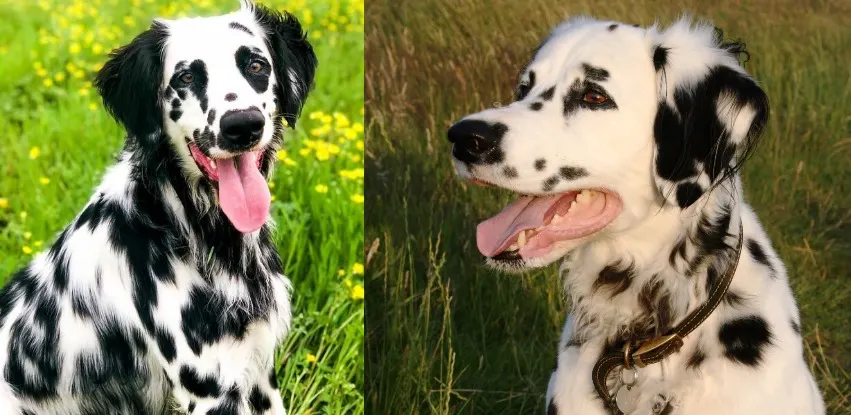Do you remember the cartoon 101 Dalmatians? If you belong to the 90´s generation you probably do, and you loved that cartoon just as much as we did. But what we also love are Dalmatian dogs. We all know about Dalmatian dogs. And we all know how they look. They have a short white fur with black dots all over. But what if I told you there are long haired Dalmatian dogs too! So instead of short fur, they have long, fluffy fur.
You’ve never heard of the long coat variety of Dalmatians? Well, they are probably a new creation. Right? No, in fact, these dogs have been around for quite some time. But, we don´t really talk about them a lot. That´s because there is somewhat of a sad story surrounding them.
We are sure you’re intrigued and you probably want to know more about them. No problem, in this article we´ll talk more about the rare long haired Dalmatian breed and we will explain to you everything there is to know about Dalmatian long haired dogs.
| Height (male) | 21 to 23 inches |
| Height (female) | 19 to 22 inches |
| Size | Medium |
| Weight | 45 to 60 pounds |
| Lifespan | 10 to 13 years |
| Price | $800 to $1,000 |
| AKC Recognition | No |
Long Haired Dalmatian – What there is to know ?
If you have never heard of the long coat Dalmatian, that´s okay. Our guess is that not many people know about this variety of Dalmatians. One reason for that is their past, but the other reason is that they aren´t considered purebred dogs.
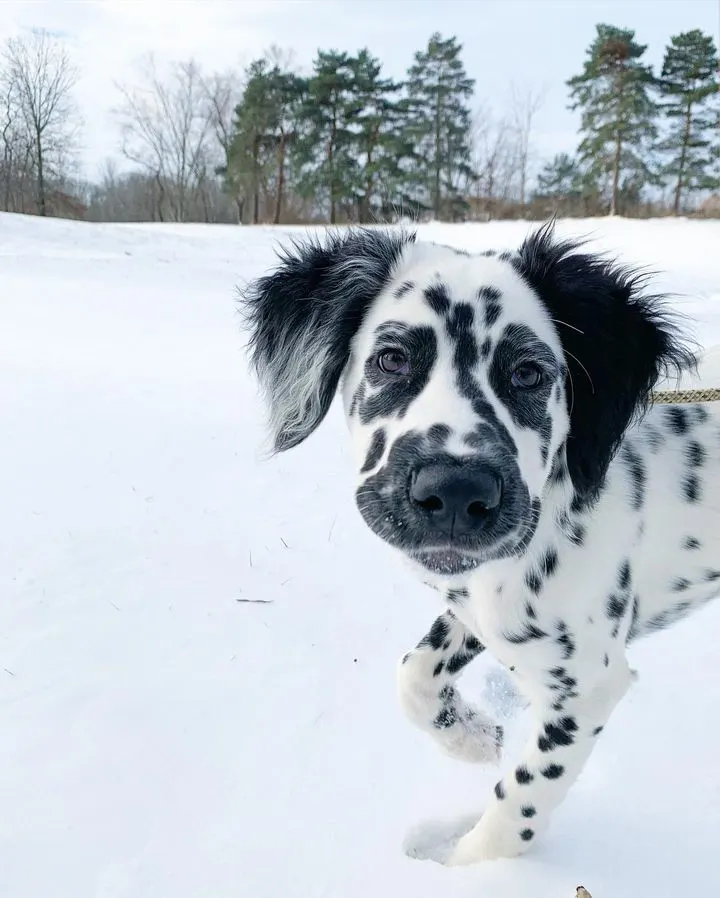
Photo: Instagram (@bebo.the.doggo)
If you´re now confused and have a thousand questions like how come there are Dalmatians with long fur or are long coat dalmatians rare? Stay calm, we will answer all of your questions and help you get to know as much as possible about this rare variety of Dalmatians.
If we were to put it as simple as possible we would say that the long-haired Dalmatian has the long-coat gene and that would be the end. This variety of Dalmatians does indeed have the long-fur gene, but it’s not that simple.
Long coat or haired Dalmatian genetics ?
Let´s dig deeper into the topic of genes and genetics. In previous articles, we have talked about genes and fur color. That´s when we explained to you that there are only two pigments that determine your dog´s coat color.
Even though there are so many coat colors in dogs, all of those colors come from only two pigments:
- eumelanin, which is black
- phaeomelanin, which is red
Both of these pigments have “set” colors that different genes modify. Simply put these genes dilute the pigment into other colors. This dilution gene is the D locus. It lightens the coat from black or brown to gray or blue or pale brown. And, as already mentioned the blue is a diluted black color. Of course, there are many other genes like the M locus, which gives dogs the Merle color. There is also the A locus which gives dogs the Agouti color, and so on.
L locus and what it does
Now let´s get back to the coat length genes, How does that exactly work? Well, besides all of the other genes dogs also carry an L locus gene or Lenght locus. It´s exactly that gene that determines your dog´s fur length.
The alleles at the L locus or the fibroblast growth factor-5 gene or FGF5 determine the length of your dog´s coat. Two known alleles occur at the L locus:
- L = Short coat
- l = Long coat
Here L is dominant to l.
This means that Dalmatians that have long coats are just a breed variation of the short-coat Dalmatians. So it´s the same breed, but with a different gene. These dogs carry a recessive gene, the recessive long-coat gene to be precise. So, to answer the question are long coat Dalmatians rare, yes, you can say Dalmatians with long fur are very rare and unique!
So, how does it exactly work? To get long-coated Dalmatian breeders to have to breed two Dalmatians that carry that gene. Some time ago there was a 50-50 distribution between the short-haired and long-haired Dalmatian. But now, the long-haired version is considered to be “bred away”. Meaning, breeders don’t produce them anymore because they aren’t recognized by various kennel clubs in the United States, including the American Kennel Club, nor can they compete in shows. Basically, any Dalmatian puppy born with long fur doesn’t fit Dalmatian AKC breed standards and they are unwanted. Sadly…
We know it sounds harsh. But it´s the reality of things. Despite being purebred dogs, and despite Dalmatians being a recognized breed, the long haired Dalmatian puppies, just don’t fit into the breed standard.
Dalmatian dog breed history ⏳
The Dalmatian’s origins remain a mystery at this time. Even though the spotted dogs are known to have traveled with nomadic bands of Romanies, often known as gypsies. But it is unknown when and where they originally emerged on the scene.
Dalmatians have been used for a variety of occupations throughout their lengthy history, and they have never been trained to specialize in a single task. In Dalmatia, they were employed as guard dogs, shepherds, ratters, retrievers, circus dogs, and coaching dogs, among other things.
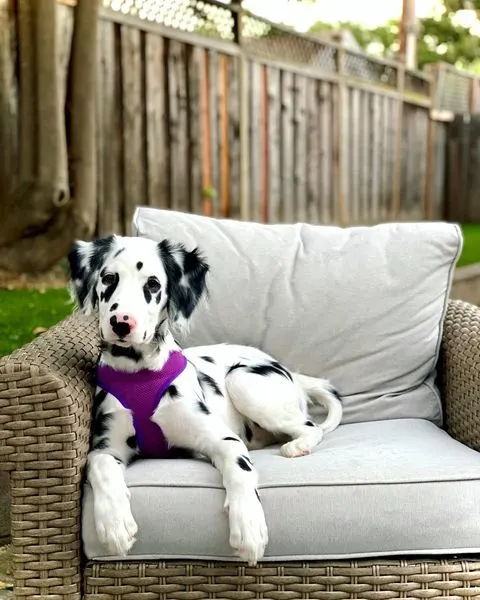
Photo: Instagram (@bentley.the.dal)
The Dalmatian was established as the ultimate coaching dog in England, where he still resides today. To make room for the horses, he would create away in front of them, or he would run beside them or beneath them between the axels. When the horses and carriage were at rest, he was in charge of their protection. Horses have always been a natural attraction for the Dalmatians, even now.
Fun fact: The Dalmatian dog got his name when he was living in Dalmatia, a region on the eastern side of the Adriatic Sea. The area the Dalmatian dog spent a lot of time in is today known as Croatia.
In the United States, the Dalmatian’s affection for dogs led him along a different professional route. His new job at the firehouse included accompanying the horses to the fire and keeping an eye on their equipment, as well as saving lives by rescuing people from burning buildings on rare occasions.
As soon as everything was over, they escorted the fire engines back to the station, where they resumed their role as watchdogs. The majority of Dalmatians are now companions and family members, although Dalmatians are still used as mascots by numerous fire departments around the nation.
What does the long haired Dalmatian look like?
How does the long-haired Dalmatian look like? There is no difference between the appearance of long hair Dalmatians and short hair Dalmatians, well except the length of their coat. We are not kidding, it really is as simple as that. The long-haired Dalmatian looks just like the short-haired Dalmatian, but with a long coat.
Dalmatian dogs are gorgeous dogs! There is no question. And we all probably know exactly what they look like, but for the sake of this article let’s go over how Dalmatians look like.
The Dalmatian is an elegant, medium-sized dog with a sleek, muscular body and a short, slender neck. This means these dogs have a medium-sized body with a muscular, but lean build. So, they are muscular but don’t look like a Pitbull for example. They are lean and much thinner. You could say they look graceful. Dalmatian dogs have round eyes that are either dark or blue and they have a very defined muzzle.
Fun fact: The most distinctive trait of Dalmatian dogs is their Dalmatian gait. Because they have such long, lean legs and a graceful body they also have a very specific way of moving their body and walking.
These dogs have very long tails with a small upward bend at the end of their length. The coat is short and thick, and it has brown or black patches on a base of white hair. No matter if you have a short-haired Dalmatian or a long haired Dalmatian, they equally shed, this breed is known for shedding excessively. To keep the shedding under control, it is necessary to brush them often, our suggestion is every other day.
Did you know that long-haired Dalmatian dogs aren’t born with those black dots? They are born with a white coat, and they later develop the spots. At about two to four weeks of age.
Like it usually is in the canine world, male Dalmatians are bigger than females. A male long-haired Dalmatian will be between 21 and 23 inches tall, while females are between 19 and 22 inches. But, both males and females weigh the same, between 45 and 60 pounds. Because they are such large dogs, they also need much room to feel comfortable.
How rare are they?
We´ve covered the history, appearance, and genes of the long haired Dalmatian, now it´s time for a somewhat controversial subject. It´s not a controversial subject that these dogs are rare, but the reason why they are very rare to come across nowadays.
The majority of you probably opened this article because you were wondering how rare long-haired Dalmatian dogs really are. Well, we’ve already mentioned that this variety of Dalmatians is very rare today. But that wasn’t always so. There was a time where short-haired and long-haired Dalmatians were evenly distributed. You could see both varieties of this dog equally present in households and on the streets. But when did it all change and why?
Well, it has a lot to do with kennel clubs in the United States and the desire of people to have dogs that are recognized by them. At some point various kennel clubs like the American Kennel Club that long haired Dalmatians don´t fit the breed standards and that only the short-haired Dalmatian should be recognized. Because of that decision, the demand for long-haired Dalmatians slowly decreased. Breeders started breeding fewer and fewer of these dogs all up until today when this variety is considered “bred away”. Today there is a very small number of Dalmatian dogs out there. Sadly, because of the decision of kennel clubs, these dogs were simply seen as “defective dogs” and breeders wanted them gone! In the past puppies were even killed.
Yes, it´s true, there was even a time when it got so bad that some breeders, especially champion breeders, even killed their long coat Dalmatian puppies just because of the length of hair and because they knew that no one would want to buy one. Luckily, this isn’t the case anymore. Long-haired Dalmatians are popular and wanted today, but they are still very rare to come across.
Health and average lifespan ❤️
We know that there is a connection between fur color and a dog’s health. For example, dogs with light coat color, for example white, are more prone to skin allergies. Dogs that have white ears are more prone to deafness. So, what about Dalmatians?
Sadly, these dogs are no exception. Because of their coat color, they are more likely to have serious health problems. Allergies and deafness are only some of them.
Fun fact: Puppies Dalmatians tend to not be very cuddly, so they will show their affection by lying next to you.
The lifespan of a Dalmatian is between 10 and 13 years. Be it a short-haired Dalmatian or a long-haired Dalmatian. It doesn’t matter. They are healthy dogs. But, they are also prone to genetic and inherited health issues. Especially because they have a light-colored coat.
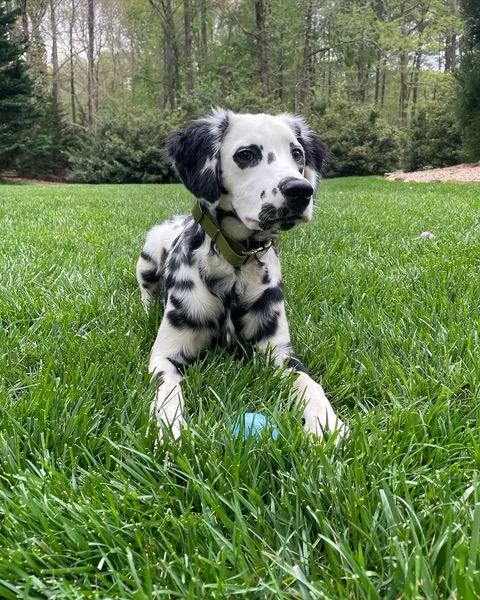
Photo: Instagram (@ziggy_lady_and_loki)
The most common health issues your Dalmatian can have
- hereditary deafness – because they have such a light coat color and usually white ears.
- urolithiasis – common condition responsible for lower urinary tract disease in dogs and cats.
- skin allergies – again, because of their light coat color they are more prone to skin allergies.
- hip dysplasia – an abnormal formation of the hip socket that, in its more severe form, can eventually cause lameness and arthritis of the joints.
- iris sphincter dysplasia – a congenital abnormality in iris development.
- hyperuricemia – a condition where the dog ends up producing too much uric acid in its system.
You should know that these are the most common health issues of Dalmatians. But, that doesn’t mean your dog will have any problems. Of course, if you take good care of them, they should be fine. But, it’s good to know what health problems your dog is susceptible to. This way you can inform yourself and know all the symptoms of possible issues. You can also request a genetic health guarantee from your breeder.
There is also a lot you Dalmatian owners can do to keep their dogs healthy, like making sure these dogs have an active lifestyle, meaning they get enough exercise! Young Dalmatians especially need a lot of activity and adequate food to grow strong and healthy.
Do long haired Dalmatians shed?
Dalmatians are Dalmatians. No matter if they have a long or short coat. They have the same health problems, the same nature, they almost look the same. But the biggest difference is the length of their coat. Taking care of a short-haired Dalmatian’s coat isn’t the same as taking care of a long-haired Dalmatian’s coat. You don’t need us to know that. But, how do you take care of a Dalmatian that has long fur?
The coat of a long-haired Dalmatian is very soft and silky. You’ll want to pet and stroke it all the time. But, the long coat doesn’t mean they stop shedding. Just like every other Dalmatian, these will shed too. Quite a bit actually. But the good thing is that their hairs don’t stick to things. So, long haired Dalmatians shed a lot, in fact, you can expect dog hair all over your house or apartment.
You should Brush your Dalmatian at least once a week. This way you’ll keep their coat healthy and shiny.
Their fur only grows about 2-4 inches on their body, so it’s not that long and shouldn’t be difficult to keep up. It’s also a good idea to shave your Dalmatian’s paw pads. If the fur on their paws grows too long, there is the risk of them slipping and falling. They could hurt themselves. If you´re wondering are long haired dalmatians hypoallergenic, we have to disappoint you. They are not. In fact, there are very few dog breeds that are indeed hypoallergenic.
What many dog owners forget to do is clean their dog’s ears. You should clean your Dalmatian’s ears regularly, or have your vet clean them. Besides this, brushing their teeth is a must too. You can also check out our article on “How to clean dog teeth without brushing?“
Lemon Dalmatian – Another unwanted variety
The Lemon Dalmatian coat color is another breed variety that doesn´t fit the Dalmatian breed standard so you will never see a Lemon Dalmatian in a dog show. When you look at the Lemon Dalmatian, you see a dog that has a pale yellow-spotted coat. It comes in different shades of yellow. Another name for this dog is the “Lemon Dally.” If you’re wondering why they have yellow spots instead of black, it’s because of genetics. This dog has cute pale-yellow spots because of a genetic mutation that makes them have pale-yellow spots.
As we all know Dalmatians have dark spots on their white coat. Usually, those dots can be either black or liver, and they are a result of a dominant “E” gene. In terms of this, it means that a liver or black-spotted Dalmatian will have either “Ee” or “EE.”
The genes look like this:
– “E” – dominant gene
– “e” – recessive gene
To get the Lemon color of dots, the black or liver color needs to get diluted. In Lemon Dalmatians, the yellow spots are caused by two copies of the “e” recessive gene. So, a Dalmatian with the “ee” gene combination will not have any dark spots but will have yellow-colored spots.
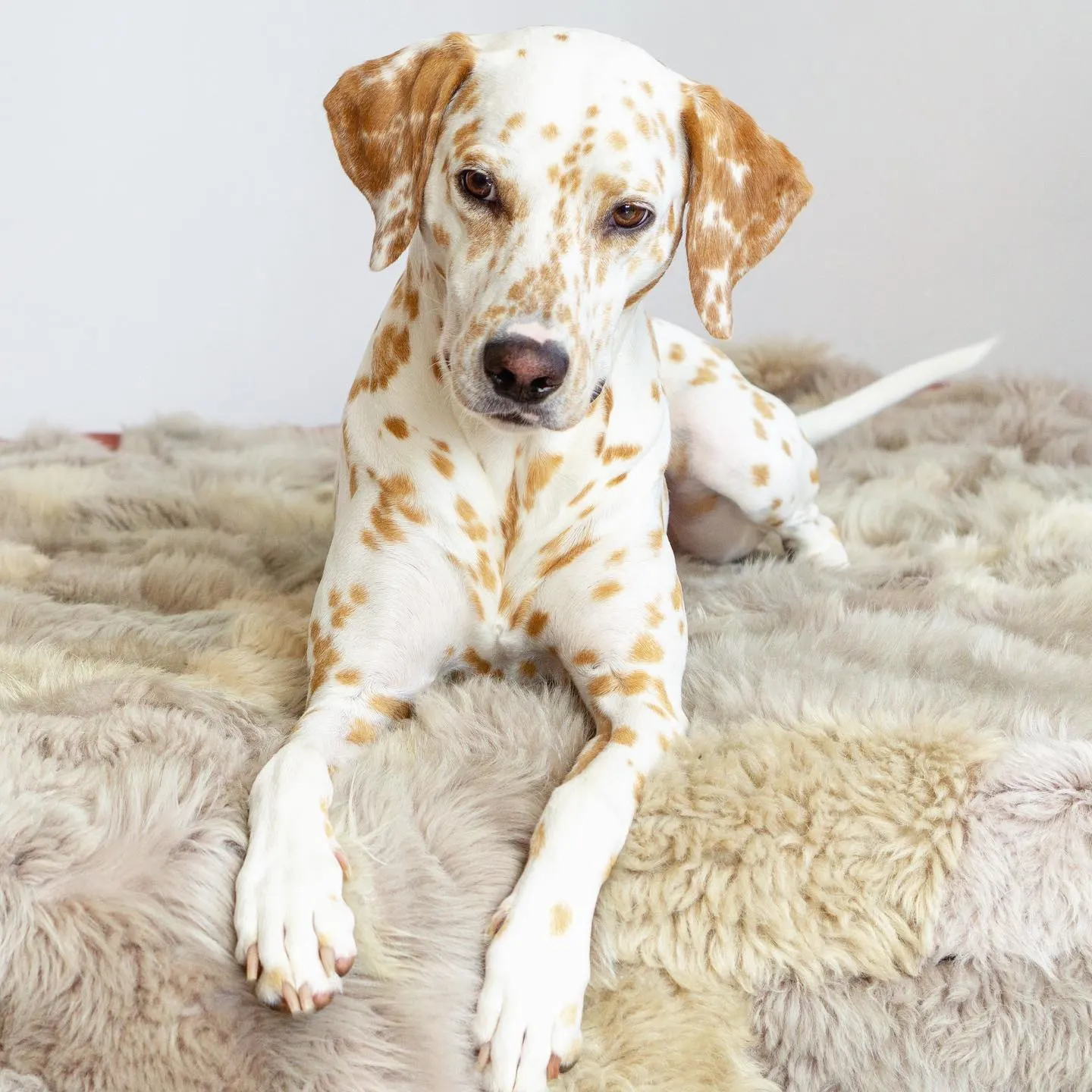
Photo: Instagram (@gepunktet)
Obviously, not all Lemon Dals will have the same shades of spots, it can vary from bright orange to pale yellow. These dogs will also have either liver or black eye rims and noses.
But if you think this variation is rare, you´re mistaken. In fact, Lemon Dalmatians are the most common of all the different types and color variations of Dalmatians. The rarest dalmatians have ink-blue spots on their white coats. But, we understand where you would get the idea that Lemon Dals are rare. You don’t really see a Lemon Dalmatian at dog shows, but if you pay close attention you might see many of them on the streets with their owners.
The yellow dots don´t affect the personality
Lemon-spotted Dalmatians have many of the same characteristics as standard Dalmatians. In this case, only a change in the dog’s coat color is going on. This does not change the dog’s qualities or behavior in any way.
Dalmatians have been used as guards and herding dogs in the past, the Lemon Dals still have these characteristics. When they are with the people they love, they will protect them and put their own lives at risk for them.
They are also very smart, loyal, playful, and sometimes even dignified, but these aren’t the only good things about them.
Lemon Dals love affection and are very happy when people show them love and care. But even though these dogs are very friendly, they’re better suited for homes with older kids.
Besides this, you need to make sure your Lemon Dalmatian is properly and consistently socialized because he can be territorial and even aggressive toward other dogs, especially those of the same breed or age group.
Read more Lemon Dalmatian: What Makes Them Special
Conclusion – Long haired Dalmatian
A long haired Dalmatian isn’t much different from a short-haired Dalmatian. Even though the AKC still doesn’t recognize them fully, they don´t consider them a recognized breed. But, it’s basically the same dog, but with a longer coat. You’re getting the same personality and almost the same look. They have the same adorable personality and will become your best friend in no time. On another note, if you do want a Dalmatian that won´t get disqualified in the show ring, then you can visit the American Kennel Club to find the AKC Dalmatians breed standard.
What´s great about them is that they get along with different people, so they could theoretically fit into every family. The Dalmatian breed is great. These dogs are smart, loving and they look graceful. You definitely can’t go wrong with them, no matter if you chose a Dalmatian with long fur or short fur. Many people aks are long haired Dalmatians aggressive. The thing is that no dog is aggressive when it gets born. Some breeds are more likely to become very aggressive if they are mistreated, but that´s on the owner again. An irresponsible and neglectful owner will turn any dog into an aggressive dog.
Sadly, you’re also getting the same health issues and problems due to their light coat color. Breed research shows that dogs who have a light coat color have a higher likelihood to get sick, get alopecia, and often become deaf or blind as they get older. There are also cases of dogs with a white or light fur color that were born deaf or blind or even both.
Find a good breeder – Important things to remember
There are so many different breeds of dogs and breed variations, just take the Dalmatian as an example, there are short-haired and long haired Dalmatians, and there are even Lemon dals! It can sometimes get overwhelming to decide which dog fits into your lifestyle, especially if you´re leading an active lifestyle. So, do a little bit of research, you can even ask breeders to help you find the right breed for you.
Having a dog is a big responsibility, especially a dog that can get this sick, a reputable long haired dalmatian breeder will sometimes ask you to fill out a short application. That application will contain questions important for the puppy´s future, like if you have other pets if you would get insurance for your dog, and so on. These questions can also help you come up with a better plan for raising a puppy. This is a great idea especially for first time owners because you can see what to expect relating to the puppy´s food intake, dalmatian temperament, how to care for long coat puppies, and so on.
There are even breeders that will offer you lifetime breeder support, meaning they will be willing to help you with any questions you might have about your dog no matter how much time has passed since buying.
We have to add that these dogs are quite expensive, especially if breeders do health screenings of the future litters. So if you´re thinking about a new addition to your family but don’t want to spend a lot of money on them, you could also adopt a long haired Dalmatian!
Read more:
- Dalmatian Husky Mix: The rare crossbreed
- Dalmatian Pitbull Mix: Rare And Demanding
- Lemon Dalmatian: What Makes Them Special
- Dalmatian Golden Retriever Mix: The Amazing Goldmation

